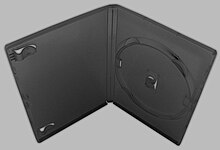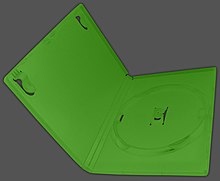
The compact disc (CD) is a digital optical disc data storage format that was co-developed by Philips and Sony to store and play digital audio recordings. The first compact disc was manufactured in August 1982, and was first released in Japan in October 1982 as Compact Disc Digital Audio. The CD was more compact than the LaserDisc (LD) developed in the 1970s. The CD gained rapid popularity in the 1990s. It quickly outsold all other audio formats in the United States by 1991, ending the market dominance of the cassette tape. By 2000, the CD accounted for 92.3% of the entire market share in regard to music sales. The CD is considered the last dominant audio format of the album era, as the rise of MP3, iTunes, cellular ringtones, and other downloadable music formats in the mid-2000s ended the decade-long dominance of the CD.
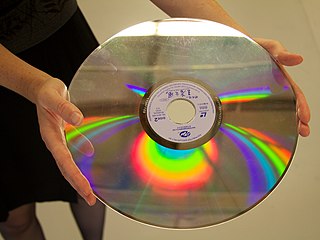
The LaserDisc (LD) is a home video format and the first commercial optical disc storage medium, initially licensed, sold and marketed as MCA DiscoVision in the United States in 1978. Its diameter typically spans 30 cm (12 in). Unlike most optical-disc standards, LaserDisc is not fully digital, and instead requires the use of analog video signals.

In computing, an optical disc drive is a disc drive that uses laser light or electromagnetic waves within or near the visible light spectrum as part of the process of reading or writing data to or from optical discs. Some drives can only read from certain discs, but recent drives can both read and record, also called burners or writers. Compact discs, DVDs, and Blu-ray discs are common types of optical media which can be read and recorded by such drives.
A regional lockout is a class of digital rights management preventing the use of a certain product or service, such as multimedia or a hardware device, outside a certain region or territory. A regional lockout may be enforced through physical means, through technological means such as detecting the user's IP address or using an identifying code, or through unintentional means introduced by devices only supporting certain regional technologies.

Optical disc packaging is the packaging that accompanies CDs, DVDs, and other formats of optical discs. Most packaging is rigid or semi-rigid and designed to protect the media from scratches and other types of exposure damage.
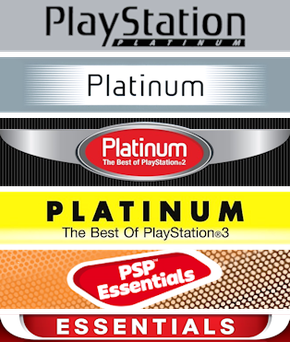
Essentials is the Sony PlayStation budget range in the PAL region, which covers Europe, the Middle East and Africa, Australia and South Asia. It was launched in January 1997 as the Platinum range but was later renamed for PlayStation Portable, PlayStation Vita, PlayStation 3 and PlayStation 4. Similar budget ranges from Sony include the Greatest Hits and The Best labels for the North American and Japanese markets, respectively.
Homebrew, when applied to video games, refers to software produced by hobbyists for proprietary video game consoles which are not intended to be user-programmable. The official documentation is often only available to licensed developers, and these systems may use storage formats that make distribution difficult, such as ROM cartridges or encrypted CD-ROMs. Many consoles have hardware restrictions to prevent unauthorized development.
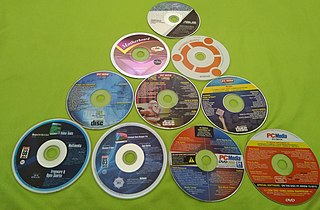
Covermount is the name given to storage media or other products packaged as part of a magazine or newspaper. The name comes from the method of packaging; the media or product is placed in a transparent plastic sleeve and mounted on the cover of the magazine with adhesive tape or glue.
Video game packaging refers to the physical storage of the contents of a PC or console game, both for safekeeping and shop display. In the past, a number of materials and packaging designs were used, mostly paperboard or plastic. Today, most physical game releases are shipped in (CD) jewel cases or (DVD) keep cases, with little differences between them.

DEVO Live 1980 is a live album and video DualDisc release by American new wave band Devo, released by Target Video in 2005.

The V.Smile is a sixth-generation educational home video game console manufactured and released by VTech. The system was first released on August 4, 2004. Its titles are available on ROM cartridges called "Smartridges", a pun on the system's educational nature. Several variants of the V.Smile console are sold, including handheld versions and models with added functionality such as touch tablet integrated controllers or microphones. The V.Motion is a variant that includes motion-sensitive controllers and has titles designed to take advantage of motion-related "active learning".

A snap case is a type of optical disc packaging, used for DVDs and CDs, also known as a paperback case, Ivy Hill Snapper, "snapper case", or FLP case.

The Farewell Tour is the third live music video title by singer-actress Cher. Released by Warner Music Video in 2003, it contained a live date from Living Proof: The Farewell Tour, filmed at American Airlines Arena in Miami on November 8, 2002. It was originally aired on April 8, 2003 as a television special on American network NBC attracting near 17 million viewers. Cher was awarded with an Emmy for Outstanding Variety, Music or Comedy Special. The same performance is also available on CD format as Live! The Farewell Tour. The video was a big success in many countries and has received several certification awards: 3× Platinum in the US, 8× Platinum in Australia and Platinum in the UK, among others respectively.
Various accessories for the PlayStation 3 video game console have been produced by Sony and third-party companies. These include controllers, audio and video input devices like microphones, video cameras, and cables for better sound and picture quality.

Blu-ray is a digital optical disc data storage format designed to supersede the DVD format. It was invented and developed in 2005 and released worldwide on June 20, 2006, capable of storing several hours of high-definition video. The main application of Blu-ray is as a medium for video material such as feature films and for the physical distribution of video games for the PlayStation 3, PlayStation 4, PlayStation 5, Xbox One, and Xbox Series X. The name refers to the blue laser used to read the disc, which allows information to be stored at a greater density than is possible with the longer-wavelength red laser used for DVDs.
The discbox slider is a 100% carton board optical disc packaging concept developed by the multinational paper and board company Stora Enso.

The Best is a Sony PlayStation budget range in Japan and parts of Asia. Similar budget ranges include Greatest Hits in North America, Essentials in PAL regions and BigHit Series in Korea.
GameCube accessories include first-party releases from Nintendo, and third-party devices, since the GameCube's launch in 2001.

A number of models of Sony's PlayStation (PS) video game console were produced from 1994 to 2006. Most revisions of the PlayStation were made to fix known hardware issues or lower production costs and time, while others featured substantial external changes.
